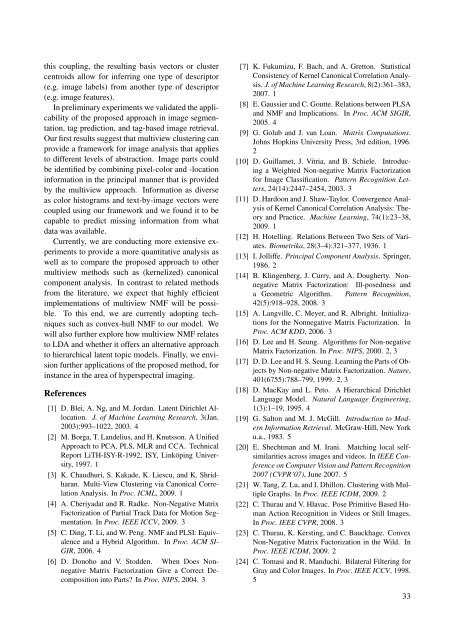16th Computer Vision Winter Workshop - lamp.tugraz.at - Graz ...
16th Computer Vision Winter Workshop - lamp.tugraz.at - Graz ...
16th Computer Vision Winter Workshop - lamp.tugraz.at - Graz ...
Create successful ePaper yourself
Turn your PDF publications into a flip-book with our unique Google optimized e-Paper software.
this coupling, the resulting basis vectors or cluster<br />
centroids allow for inferring one type of descriptor<br />
(e.g. image labels) from another type of descriptor<br />
(e.g. image fe<strong>at</strong>ures).<br />
In preliminary experiments we valid<strong>at</strong>ed the applicability<br />
of the proposed approach in image segment<strong>at</strong>ion,<br />
tag prediction, and tag-based image retrieval.<br />
Our first results suggest th<strong>at</strong> multiview clustering can<br />
provide a framework for image analysis th<strong>at</strong> applies<br />
to different levels of abstraction. Image parts could<br />
be identified by combining pixel-color and -loc<strong>at</strong>ion<br />
inform<strong>at</strong>ion in the principal manner th<strong>at</strong> is provided<br />
by the multiview approach. Inform<strong>at</strong>ion as diverse<br />
as color histograms and text-by-image vectors were<br />
coupled using our framework and we found it to be<br />
capable to predict missing inform<strong>at</strong>ion from wh<strong>at</strong><br />
d<strong>at</strong>a was available.<br />
Currently, we are conducting more extensive experiments<br />
to provide a more quantit<strong>at</strong>ive analysis as<br />
well as to compare the proposed approach to other<br />
multiview methods such as (kernelized) canonical<br />
component analysis. In contrast to rel<strong>at</strong>ed methods<br />
from the liter<strong>at</strong>ure, we expect th<strong>at</strong> highly efficient<br />
implement<strong>at</strong>ions of multiview NMF will be possible.<br />
To this end, we are currently adopting techniques<br />
such as convex-hull NMF to our model. We<br />
will also further explore how multiview NMF rel<strong>at</strong>es<br />
to LDA and whether it offers an altern<strong>at</strong>ive approach<br />
to hierarchical l<strong>at</strong>ent topic models. Finally, we envision<br />
further applic<strong>at</strong>ions of the proposed method, for<br />
instance in the area of hyperspectral imaging.<br />
References<br />
[1] D. Blei, A. Ng, and M. Jordan. L<strong>at</strong>ent Dirichlet Alloc<strong>at</strong>ion.<br />
J. of Machine Learning Research, 3(Jan.<br />
2003):993–1022, 2003. 4<br />
[2] M. Borga, T. Landelius, and H. Knutsson. A Unified<br />
Approach to PCA, PLS, MLR and CCA. Technical<br />
Report LiTH-ISY-R-1992, ISY, Linköping University,<br />
1997. 1<br />
[3] K. Chaudhuri, S. Kakade, K. Liescu, and K. Shridharan.<br />
Multi-View Clustering via Canonical Correl<strong>at</strong>ion<br />
Analysis. In Proc. ICML, 2009. 1<br />
[4] A. Cheriyad<strong>at</strong> and R. Radke. Non-Neg<strong>at</strong>ive M<strong>at</strong>rix<br />
Factoriz<strong>at</strong>ion of Partial Track D<strong>at</strong>a for Motion Segment<strong>at</strong>ion.<br />
In Proc. IEEE ICCV, 2009. 3<br />
[5] C. Ding, T. Li, and W. Peng. NMF and PLSI: Equivalence<br />
and a Hybrid Algorithm. In Proc. ACM SI-<br />
GIR, 2006. 4<br />
[6] D. Donoho and V. Stodden. When Does Nonneg<strong>at</strong>ive<br />
M<strong>at</strong>rix Factoriz<strong>at</strong>ion Give a Correct Decomposition<br />
into Parts? In Proc. NIPS, 2004. 3<br />
[7] K. Fukumizu, F. Bach, and A. Gretton. St<strong>at</strong>istical<br />
Consistency of Kernel Canonical Correl<strong>at</strong>ion Analysis.<br />
J. of Machine Learning Research, 8(2):361–383,<br />
2007. 1<br />
[8] E. Gaussier and C. Goutte. Rel<strong>at</strong>ions between PLSA<br />
and NMF and Implic<strong>at</strong>ions. In Proc. ACM SIGIR,<br />
2005. 4<br />
[9] G. Golub and J. van Loan. M<strong>at</strong>rix Comput<strong>at</strong>ions.<br />
Johns Hopkins University Press, 3rd edition, 1996.<br />
2<br />
[10] D. Guillamet, J. Vitria, and B. Schiele. Introducing<br />
a Weighted Non-neg<strong>at</strong>ive M<strong>at</strong>rix Factoriz<strong>at</strong>ion<br />
for Image Classific<strong>at</strong>ion. P<strong>at</strong>tern Recognition Letters,<br />
24(14):2447–2454, 2003. 3<br />
[11] D. Hardoon and J. Shaw-Taylor. Convergence Analysis<br />
of Kernel Canonical Correl<strong>at</strong>ion Analysis: Theory<br />
and Practice. Machine Learning, 74(1):23–38,<br />
2009. 1<br />
[12] H. Hotelling. Rel<strong>at</strong>ions Between Two Sets of Vari<strong>at</strong>es.<br />
Biometrika, 28(3–4):321–377, 1936. 1<br />
[13] I. Jolliffe. Principal Component Analysis. Springer,<br />
1986. 2<br />
[14] B. Klingenberg, J. Curry, and A. Dougherty. Nonneg<strong>at</strong>ive<br />
M<strong>at</strong>rix Factoriz<strong>at</strong>ion: Ill-posedness and<br />
a Geometric Algorithm. P<strong>at</strong>tern Recognition,<br />
42(5):918–928, 2008. 3<br />
[15] A. Langville, C. Meyer, and R. Albright. Initializ<strong>at</strong>ions<br />
for the Nonneg<strong>at</strong>ive M<strong>at</strong>rix Factoriz<strong>at</strong>ion. In<br />
Proc. ACM KDD, 2006. 3<br />
[16] D. Lee and H. Seung. Algorithms for Non-neg<strong>at</strong>ive<br />
M<strong>at</strong>rix Factoriz<strong>at</strong>ion. In Proc. NIPS, 2000. 2, 3<br />
[17] D. D. Lee and H. S. Seung. Learning the Parts of Objects<br />
by Non-neg<strong>at</strong>ive M<strong>at</strong>rix Factoriz<strong>at</strong>ion. N<strong>at</strong>ure,<br />
401(6755):788–799, 1999. 2, 3<br />
[18] D. MacKay and L. Peto. A Hierarchical Dirichlet<br />
Language Model. N<strong>at</strong>ural Language Engineering,<br />
1(3):1–19, 1995. 4<br />
[19] G. Salton and M. J. McGill. Introduction to Modern<br />
Inform<strong>at</strong>ion Retrieval. McGraw-Hill, New York<br />
u.a., 1983. 5<br />
[20] E. Shechtman and M. Irani. M<strong>at</strong>ching local selfsimilarities<br />
across images and videos. In IEEE Conference<br />
on <strong>Computer</strong> <strong>Vision</strong> and P<strong>at</strong>tern Recognition<br />
2007 (CVPR’07), June 2007. 5<br />
[21] W. Tang, Z. Lu, and I. Dhillon. Clustering with Multiple<br />
Graphs. In Proc. IEEE ICDM, 2009. 2<br />
[22] C. Thurau and V. Hlavac. Pose Primitive Based Human<br />
Action Recognition in Videos or Still Images.<br />
In Proc. IEEE CVPR, 2008. 3<br />
[23] C. Thurau, K. Kersting, and C. Bauckhage. Convex<br />
Non-Neg<strong>at</strong>ive M<strong>at</strong>rix Factoriz<strong>at</strong>ion in the Wild. In<br />
Proc. IEEE ICDM, 2009. 2<br />
[24] C. Tomasi and R. Manduchi. Bil<strong>at</strong>eral Filtering for<br />
Gray and Color Images. In Proc. IEEE ICCV, 1998.<br />
5<br />
33

















